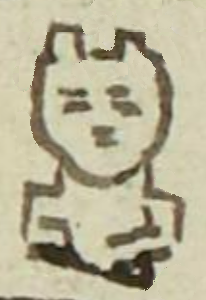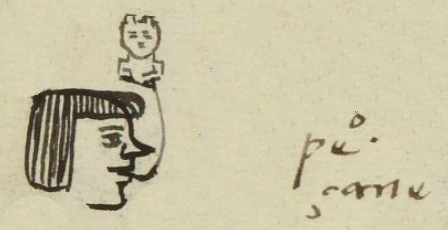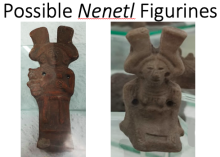Zanen (MH629r)
This black-line drawing of the simplex glyph for the personal name Zanen ("In Vain," also spelled Zannen) is attested here as a man's name. It shows a sculptural representation of a divine force or deity (nenetl). It serves as a phonetic indicator for the second part (nen) of the personal name, which has a different meaning. The representation/presentation or ixiptlatl of the divine force is shown in a frontal view with an anthropomorphic face and two squared-off protrusions on the top of its head.
Stephanie Wood
The vast majority of glyphs or glyphic elements that include the ne- or nen- syllable as a phonogram, typically expressing a negative such as idleness or low productivity, will show figurines in a frontal view. The figurines can be either full bodied, just the bust, or just the head. The syllable nen- comes from the term nenetl, which, as translated by Alonso de Molina, means doll, deity image, or woman’s genitals. These are three very different meanings, although a doll and a figurine of a divine force/deity could have a similar look. The glyphic representations almost always show such figurines, although it can be difficult to tell if they represent dolls or deities and the gender can be vague. To my knowledge, Alfonso Lacadena (2008a, 21) was the first to publish the interpretation of the nenetl glyph as the phonetic syllable "ne-", which in my experience is more typically nen- and which is more likely to have negative implications.
Keiko Yoneida writes about the negative reading of nenetl “fetiches” as “useless” or “in vain,” which she suggests is a patriarchal deprecation of women. See her discussion of nenetl and the nemontemi days in the calendar in her study, Los Mapas de Cuauhtinchan y la historia cartográfica prehispánica (1991), 140. A few nenetl glyphs or elements in this digital collection do not include the negative nen-, although most do, and most are female, but a few are male or genderless.
One of the diagnostics for nenetl involves squared-off protrusions on the top of the head. If these are not protrusions such as the glyphs for Cuauhtecolotl or Xolotl have (below), perhaps they are stylized representations of the hairstyle called neaxtlahualli, where the Nahua sedentary woman wears locks of hair twisted up into two points over each side of her forehead. Fortunately, figurines with squared-off protrusions on their heads have survived from pre-contact times. The Museo Tomás Medina Villarruel has a number of them. These are mostly female, with skirts and breasts, and they are often shown in activities such as carrying children or grinding maize. Two images from that collection appear below. These figurines may well be dolls rather than deities.
Ian Mursell has published a photo of such a figurine in an article he shares about rattle figurines. In the image in Mexicolore, the figure on the left fits the nenetl characteristics with its protrusions on its head, and since it is a rattle one could call it a female doll. Other small figurines of women are published in the Museo de Sitio de Tlatelolco (2012, 235); they vaguely resemble dolls and they have interesting headdresses. In that same book, on p. 236, one sees "figurillas femeninas tipo galleta," which are something like dolls that could also be deity sculptures. Again, here, the protrusions of hair at the top of the head more closely resemble the nenetl protrusions.
Stephanie Wood
pe.
çane
Pedro Zanen
Stephanie Wood
1560
Jeff Haskett-Wood
deities, deidades, images, ixiptla, sculpture, escultura, imagen, fuerzas divinas, divinidades, divinities, religión, nombres de hombres
Photo credit: Eduardo Flores. Museo Tomás Medina Villarruel, Tlahuac, CDMX.

zanen, in vain, https://nahuatl.wired-humanities.org/content/zanen
za, merely, just, or only, https://nahuatl.wired-humanities.org/content/za
nen-, in vain, uselessly, for nothing, https://nahuatl.wired-humanities.org/content/nen
nene(tl), deity image, doll, or woman’s genitals, https://nahuatl.wired-humanities.org/content/nenetl
En Vano
Stephanie Wood
Matrícula de Huexotzinco, folio 629r, World Digital Library, https://www.loc.gov/resource/gdcwdl.wdl_15282/?sp=341&st=image.
This manuscript is hosted by the Library of Congress and the World Digital Library; used here with the Creative Commons, “Attribution-NonCommercial-ShareAlike 3.0 License” (CC-BY-NC-SAq 3.0).














